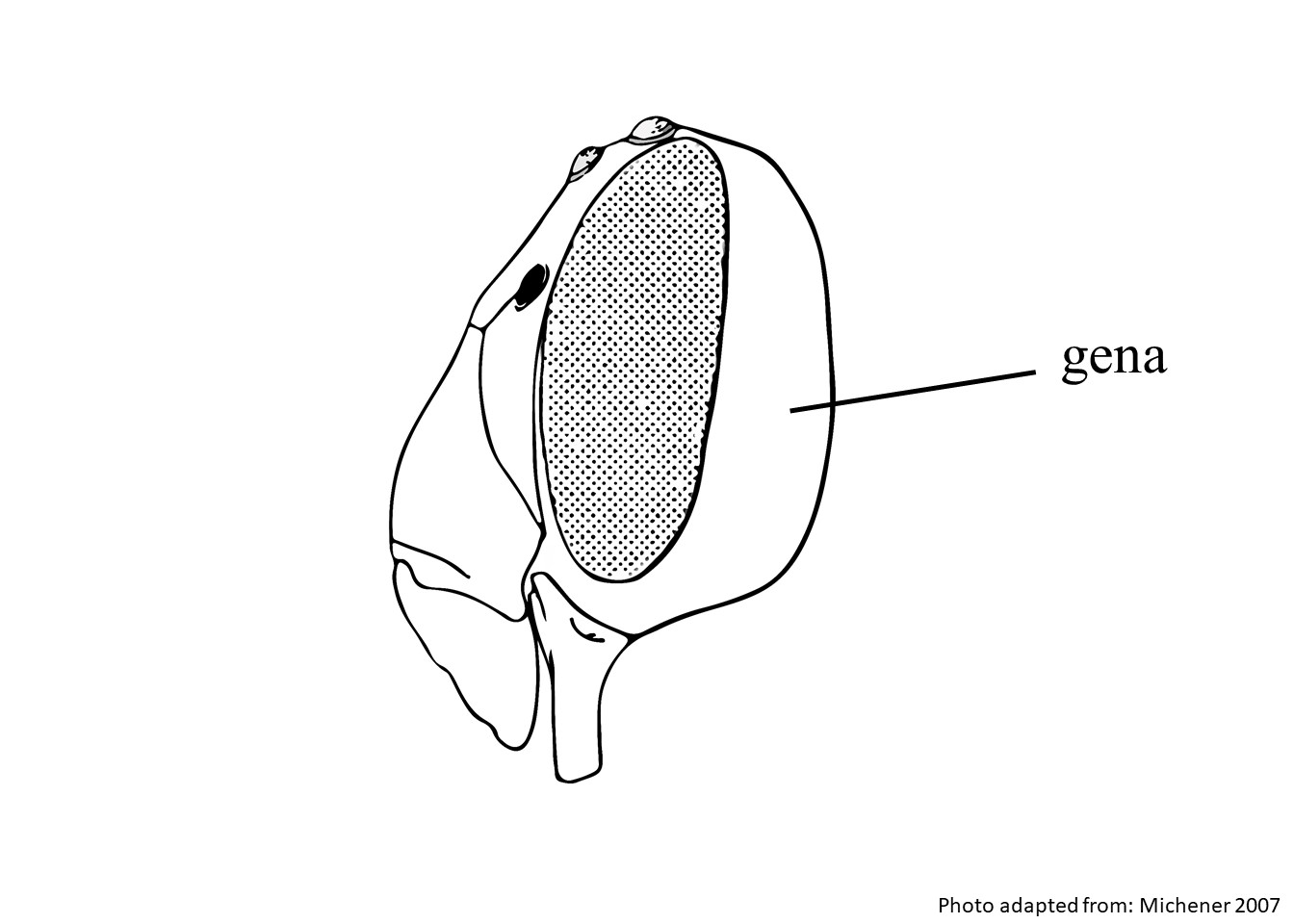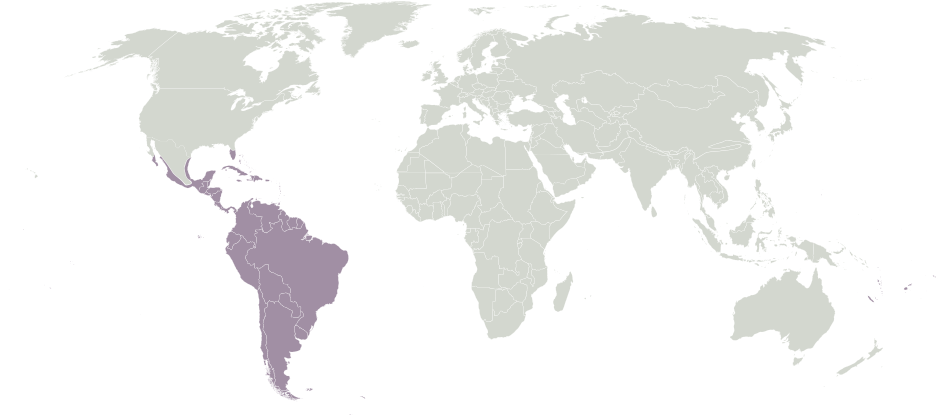Family: Megachilidae
Subfamily: Megachilinae
Tribe: Megachilini
Genus: Megachile Latreille, 1802
Subgenus: Leptorachina Mitchell, 1980
Common name: none
Megachile (Leptorachina) are large, robust bees with black integumentintegument:
a tough, protective outer layer
on their head, thorax, and abdomen, and sometimes with red to brown integumentintegument:
a tough, protective outer layer
on their antenna, legs, mandibles, and tegulategula:
the usually oval, small shield-like structure carried at the extreme base of the wing where it attaches to the body (Mitchell 1928Mitchell 1928:
Mitchell, T.B. 1928. A contribution to the knowledge of neotropical Megachile with descriptions of new species (Hymenoptera: Megachilidae). Transactions of the American Entomological Society 56(3): 155-306.). They have primarily white hair with various clusters of dark or intermixed hair throughout their body and apicalapical:
near or at the apex or end of any structure
bands of white hair on the tergaterga:
the segments on the top side of the abdomen, often abbreviated when referring to a specific segment to T1, T2, T3, T4, T5, T6, or T7 (Mitchell 1928Mitchell 1928:
(Mitchell 1928Mitchell 1928:
Mitchell, T.B. 1928. A contribution to the knowledge of neotropical Megachile with descriptions of new species (Hymenoptera: Megachilidae). Transactions of the American Entomological Society 56(3): 155-306.). They have a body length of approximately 14 mm (Mitchell 1928Mitchell 1928:
Mitchell, T.B. 1928. A contribution to the knowledge of neotropical Megachile with descriptions of new species (Hymenoptera: Megachilidae). Transactions of the American Entomological Society 56(3): 155-306.).
(modified from Mitchell 1928Mitchell 1928:
Mitchell, T.B. 1928. A contribution to the knowledge of neotropical Megachile with descriptions of new species (Hymenoptera: Megachilidae). Transactions of the American Entomological Society 56(3): 155-306.; Mitchell 1980Mitchell 1980:
Mitchell, T.B. 1980. A generic revision of the megachiline bees of the Western Hemisphere. Department of Entomology, North Carolina State University, 95 pp.; Gonzalez et al. 2019Gonzalez et al. 2019:
Gonzalez, V.H., G.T. Gustafson, and M.S. Engel. 2019. Morphological phylogeny of Megachilini and the evolution of leaf-cutter behavior in bees (Hymenoptera: Megachilidae). Journal of Melittology (85): 1-123.)
 narrower than the width of the eye.
narrower than the width of the eye. with hair absent in the center of the discdisc:
with hair absent in the center of the discdisc: with laterallateral:
with laterallateral:Megachile (Leptorachina) is similar to Megachile (Leptorachis) with the females of both subgenera having four-toothed mandibles with a small second interspace and mostly bare S6S6:
the plates on the underside of the abdomen, often abbreviated when referring to a specific segment to S1, S2, S3, S4, S5, S6, S7, or S8
 . Males are also similar by having very short tibial spurs on their mid-leg. Female M. (Leptorachina) can be differentiated by the low shiny carinacarina:
. Males are also similar by having very short tibial spurs on their mid-leg. Female M. (Leptorachina) can be differentiated by the low shiny carinacarina:
a clearly defined ridge or keel, not necessarily high or acute; usually appears on bees as simply a raised line
bordered with a row of white hairs (Gonzalez et al. 2019Gonzalez et al. 2019:
Gonzalez, V.H., G.T. Gustafson, and M.S. Engel. 2019. Morphological phylogeny of Megachilini and the evolution of leaf-cutter behavior in bees (Hymenoptera: Megachilidae). Journal of Melittology (85): 1-123.). Male M. (Leptorachina) can be easily separated from M. (Leptorachis) by the expanded tarsitarsi:
the group of segments at the end of the leg following the tibia
on the front leg (Mitchell 1980Mitchell 1980:
Mitchell, T.B. 1980. A generic revision of the megachiline bees of the Western Hemisphere. Department of Entomology, North Carolina State University, 95 pp.).
Megachile (Leptorachina) have been observed visiting flowers from multiple plant families including: Asteraceae, Fabaceae, Lamiaceae, Oxalidaceae, and Verbenaceae (Mateus 1998Mateus 1998:
Mateus, S. 1998. Abundacirc;ncia relativa, fenologia e visita agrave;s flores pelos Apoidea do Cerrado da Estaccedil;atilde;o Ecoloacute;gica de Jataiacute;-Luiz Antocirc;nio-SP (Doctoral dissertation, Universidade de Satilde;o Paulo: 159 pp; Freitas and Sazima 2006Freitas and Sazima 2006:
Freitas, L. and M. Sazima. 2006. Pollination biology in a tropical high-altitude grassland in Brazil: interactions at the community level. Annals of the Missouri Botanical Garden 93(3): 465-516.; Almeida and Laroca 2013Almeida and Laroca 2013:
Almeida, M.C. and S. Laroca. 2013. Biocoenotics and taxonomy of wild bees (Hymenoptera, Anthophila) of restricted areas of cerrado (savanna) in Jaguariaiacute;va vicinities, Paranaacute; state, south Brazil. Acta Bioloacute;gica Paranaense 42(3-4): 29-194.; dos Santos 2013dos Santos 2013:
dos Santos, R.D.C. 2013. Efeitos do fogo sobre a estrutura de comunidades de abelhas e sobre redes de interaccedil;otilde;es abelha-planta em aacute;reas de canga no Parque Estadual da Serra do Rola Moccedil;a. Dissertation Universidade Federal De Minas Gerias: 119 pp.).
Nesting behavior unknown.
Megachile (Leptorachina) includes a single species, Megachile laeta (Michener 2007Michener 2007:
Michener, C.D. 2007. The Bees of the World (2nd ed.). Johns Hopkins University Press, Baltimore and London, 953 pp.).
There are no known invasives.
Megachile (Leptorachina) is known from Central and South America, where they range from Costa Rica to Brazil and Paraguay (Raw 2007Raw 2007:
Raw, A. 2007. An annotated catalogue of the leafcutter and mason bees (genus Megachile ) of the Neotropics. Zootaxa 1601: 1-127.; Ramos et al. 2015Ramos et al. 2015:
Ramos, K.S., R. Kawada, and C.R.F. Brandatilde;o. 2015. Type specimens of bees (Hymenoptera, Apidae) deposited in the Museu de Zoologia da Universidade de Satilde;o Paulo, Brazil. Papeacute;is Avulsos de Zoologia 55(24): 335-361.).

Distribution map generated by Discover Life -- click on map for details, credits, and terms of use.
Almeida, M.C. and S. Laroca. 2013. Biocoenotics and taxonomy of wild bees (Hymenoptera, Anthophila) of restricted areas of cerrado (savanna) in Jaguariaíva vicinities, Paraná state, south Brazil. Acta Biológica Paranaense 42(3-4): 29-194.
dos Santos, R.D.C. 2013. Efeitos do fogo sobre a estrutura de comunidades de abelhas e sobre redes de interações abelha-planta em áreas de canga no Parque Estadual da Serra do Rola Moça. Dissertation Universidade Federal De Minas Gerias: 119 pp.
Freitas, L. and M. Sazima. 2006. Pollination biology in a tropical high-altitude grassland in Brazil: interactions at the community level. Annals of the Missouri Botanical Garden 93(3): 465-516.
Gonzalez, V.H., G.T. Gustafson, and M.S. Engel. 2019. Morphological phylogeny of Megachilini and the evolution of leaf-cutter behavior in bees (Hymenoptera: Megachilidae). Journal of Melittology 85: 1-123.
Mateus, S. 1998. Abundância relativa, fenologia e visita às flores pelos Apoidea do Cerrado da Estação Ecológica de Jataí-Luiz Antônio-SP (Doctoral dissertation, Universidade de São Paulo: 159 pp.
Michener, C.D. 2007. The Bees of the World (2nd ed.). Johns Hopkins University Press, Baltimore and London, 953 pp.
Mitchell, T.B. 1928. A contribution to the knowledge of neotropicalNeotropical:
biogeographic region that includes South and Central America, the Caribbean Islands, southern Florida, and the southern Mexican lowlands Megachile with descriptions of new species (Hymenoptera: Megachilidae). Transactions of the American Entomological Society 56(3): 155-306.
Megachile with descriptions of new species (Hymenoptera: Megachilidae). Transactions of the American Entomological Society 56(3): 155-306.
Mitchell, T.B. 1980. A generic revision of the megachiline bees of the Western Hemisphere. Department of Entomology, North Carolina State University, 95 pp.
Ramos, K.S., R. Kawada, and C.R.F. Brandão. 2015. Type specimens of bees (Hymenoptera, Apidae) deposited in the Museu de Zoologia da Universidade de São Paulo, Brazil. Papéis Avulsos de Zoologia 55(24): 335-361.
Raw, A. 2007. An annotated catalogue of the leafcutter and mason bees (Genus Megachile) of the Neotropics. Zootaxa 1906: 1-127.